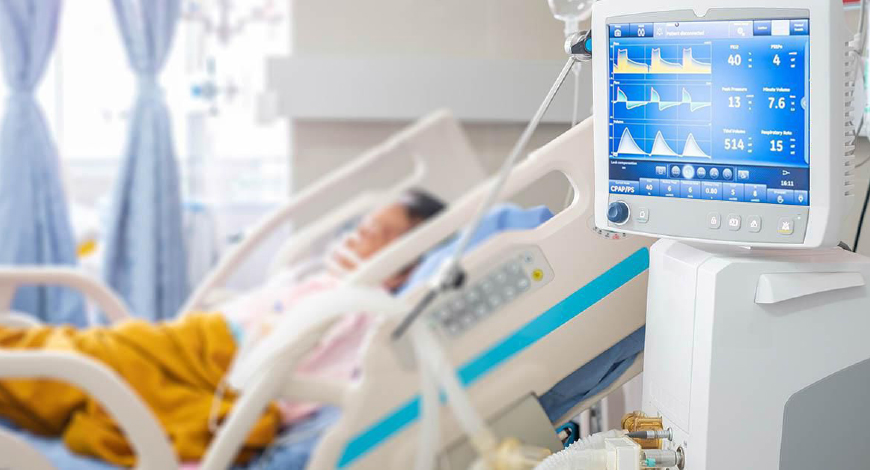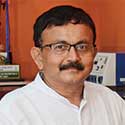MB Stories
An unpredictable market

Prior to the onset of COVID-19, the ventilators market was stable, with several established brands including Dräger, Getinge, Hamilton, Medtronic, Philips, and GE. The number of patients requiring ventilators exploded as the first wave of the pandemic hit, and what had been a stable supply chain for years became a healthcare bottleneck in a matter of weeks. Order books were overflowing, with inventories at absymally low levels, orders came from not only regular customers like hospitals, but also directly from the government. To meet the demand, the manufacturers of ventilators relied on partnerships between medical manufacturers and companies that provided additional production capacity.
Regulatory authorities accelerated the approval process. The FDA, for instance waived the submission of premarket notification of modified ventilators where the modification would not give rise to an undue concern and allowed alternative devices capable of delivering breath or pressure support during the COVID-19 pandemic.
The majority of the prototypes built for the pandemic are portable transport ventilators. Most devices had received regulatory approval prior to the outbreak. They offered critical care patient support for all age groups. The pneumatically powered models have no need for batteries or electrical power, making them suitable for transport or makeshift spaces. Some emergency ventilators tailored for COVID-19 patients only meet the minimally clinically acceptable standards, with a life span of only three to four months.
The trend is now moving toward a normalized demand for COVID-19-related devices. The global demand for ventilators is expected to steadily return to normal with a gradual decrease in sales in the coming year. The actual usage of ventilators has proven to be lower than original projections as the pandemic has progressed and clinical knowledge has improved.
The outlook of the ventilators market looks positive as the majority of recently mass-produced ventilators are considered emergency ventilators. These ventilators cannot generate the precise air delivery required for patients with acute respiratory distress syndrome (ARDS), nor provide decision support tools for lung-protective ventilation. There are still regions with demand for advanced ICU ventilators that are designed for invasive ventilation of severe patients during their ICU stay. Additionally, the pandemic positively impacted the market for overall respiratory care infrastructure.
The Indian ventilators market in 2020 is estimated at 39445 units, valued at ₹3304.36 crore. 2020 was a year unlike any other in the history of the Indian ventilator market. The government, under the PM-Cares Fund allocated ₹2000 crore for procurement of this product. The indigenous ventilator segment dominated at 71 percent share by value, and 61.68 percent by volume, a never-before trend. The imported ventilator segment, albeit at an all-time high at 12113 units, estimated at ₹833 crore, lost its traditional dominance and was a mere 30 percent share by quantity and 25 percent by value. This was more due to the supply chain constraint, since the parent companies had to cater to their respective domestic demand before they made the product available for exports to India.
| Indian market for imported ventilators | ||
| Major vendors* – 2020 | ||
| Tier I | Tier II | Others |
| Draeger, GE, Hamilton, Aeon Medical, Mindray, and Maquet |
Schiller, Philips, Vyaire, Air Liquide, IMT-Carefusion, & Covidien | BPL, MEK ICS, Hoffrichter GmbH, and Flight Medical |
| *Vendors are placed in different tiers on the basis of their sales contribution to the overall revenues of the Indian ventilators market. | ||
| Indian market for indigenous ventilators Order status under PM-Cares Fund (Sept 2020) |
|||||||||||||
| Manufacturer | Date of purchase order | Model nr. | Qty. ordered |
Qty. supplied |
Unit price, incl GST (lakh) | Value (₹cr.) |
|||||||
| BEL-Skanray* | March 27 | CV 200 | 30,000 | 24,332 | ₹5 | 1513.00 | |||||||
| Orders placed by Hindustan Lifecare Limited | |||||||||||||
| AgVa | March 27 | AV-Ad-COVID | 10,000 | 5,000 | ₹1.66 | 166.37 | |||||||
| AMTZ Basic | April 2 | – | 9,500 | – | ₹1.66 | 158.05 | |||||||
| Jyoti CNC | April 16 | Dhaman 3 | 5,000 | – | ₹2.41 | 120.96 | |||||||
| AMTZ Advanced** | April 16 | Model HFO | 4,000 | – | ₹8.56 | 342.00 | |||||||
| Allied Medical | March 27 | Meditec 1700 | 350 | 350 | ₹8.6 | 30.18 | |||||||
| Wipro | April 9 | GE R860 | 100 | 10 | ₹13.94 | 13.90 | |||||||
| BPL | April 9 | ELISA300 | 8 | 8 | ₹14.28 | 1.14 | |||||||
| BPL | April 9 | ELISA600 | 5 | 5 | ₹15.34 | 0.76 | |||||||
| Total | 30,000 | 24,332 | 2346.36 | ||||||||||
| *Bharat Electronics Limited-Skanray contract was handled directly by MoHFW | |||||||||||||
The leap in procurement in 2020 over 2019 is absolutely mind-boggling. By quantity, the indigenous machines saw an increase by 2333 percent, the imported segment by 122 percent and the total segment by 363 percent. On a similar note, by value, the indigenous machines saw an increase by 7990 percent, the imported segment by 148 percent and the total segment by 643 percent. The refurbished and ambulatory segments got lost in this maze.
2021 is seeing a different trend. The government, that was the large buyer in 2020 is largely staying away, partly as its requirement has been met, there are some supplies still unopened and the coronavirus focus has somewhat shifted to its counterpart, oxygen therapy products.
This year, NGOs have been a new segment of buyers, as have companies buying them as part of their corporate social responsibility (CSR) initiative. For instance, Sir HN Reliance Foundation Hospital, now managing a 650-bed facility at National Sports Club of India, Worli, Mumbai bought ventilators as it set up its project buying ICU beds and monitors. The Reliance Medical team is also augmenting the number of ventilators across their medical facilities in all the locations. L&T procured and supplied 24 high-end ventilators, Allied Meditec 1700 to SMIMER, Civil and other dedicated COVID-19 hospitals in South Gujarat. The company also supplied ventilators to government hospitals in Madurai, Tuticorin, Tirunelveli, Virudhnagar and to COVID centres in Chennai. Hindustan Unilever Limited donated 34 ventilators worth ₹4 crore to the Maharashtra government. This included ventilators worth ₹1.5 crore donated to the Municipal Corporation of Greater Mumbai and worth ₹1 crore to the Pune Municipal Corporation. The rest were sent to civil hospitals in Chiplun, Ratnagiri and Nashik, where the company has its factories. Hyundai Motor India Foundation, as part of its CSR project Back-to-life purchased 225 BiPap ventilator machines and expedited deliveries to the most affected states including New Delhi, Maharashtra, Tamil Nadu, Haryana and Telangana. It also entered into a strategic partnership with Air Liquide Medical Systems to augment production and supply of 1,000 ventilators. Maruti Suzuki India also made an arrangement with AgVa Healthcare to scale up production of ventilators to reach a volume of 10,000 units per month. Additionally, it gave 50 ventilators to Haryana government. Other companies are also on a similar spree.
 Equipment and protocols go hand in hand
Equipment and protocols go hand in hand
Vishwaprasad Alva
Founder and Managing Director,
Skanray Technologies
On March 18, 2020, when NITI Aayog, Commerce Ministry, Pharma and Health ministries called Skanray, the situation was that, there was an installed base of 18000 ventilators of which about 7000-8000 were out of service and there was an estimated need for 100,000 ICU ventilators.
None of the medical practitioners had a clue on COVID ICU protocols since China, which was the epicenter of the COVID virus had not shared the data on infection or treatment.
It was a good guess by the government that high-end ventilators were needed to treat COVID-like any acute respiratory distress syndrome (ARDS) and that Skanray and Max Ventilators (AB Industries) were the only ICU ventilators in the country. The annual demand in the country was about 1000 ICU ventilators and 80 percent of this was supplied by the multinationals. The pandemic brought in a huge demand globally and the 6 or 7 countries around the world that manufactured ICU ventilators had huge domestic demand and were not able to supply to India.
Swift action from the government, and partnership between Skanray, BEL, and DRDO created a world record by supplying 30,000 units in 3 months. Max, AMTZ, AgVa, and few other startups too joined the supply chain.
The government also did the transaction through a unique government-to-government transaction to eliminate middle men by involving BEL as the supplier that is under the ministry of defense, making it one of the fastest and most transparent deal ever.
In the course of delivery, clarity emerged on the practice and use protocols and the empowered committee and AIIMS revised the specs to add the requisite features, and the industry quickly responded to that too.
Warnings related to shortage of trained intensivist and respiratory technicians in the country weren’t really taken seriously and as deliveries started, for want of trained professionals, we started seeing these units being piled up in godowns. The market was flooded with spurious products and cheap imports, and issues relating to shortage of staff and ventilator failures got embroiled into a huge media mashup.
BEL, with its wide network did a commendable job of installing and servicing the huge numbers, which was not an ordinary feat. During the second wave, these ventilators got dusted, cleaned and installed as NIVs and BIPAPs/HFOTs, which came in handy and saved thousands of lives. Even today, due to shortage of staff, the ventilators are not 100 percent deployed, but the utilization has been good, and gradually the hospitals will evolve new ways to train and utilize them, in case of the third wave.
Equipment, accessories, oxygen lines, infrastructure and protocols go hand in hand. Nothing is useful standalone.
The private hospitals are expected be a huge buyer in 2021. They are now gearing up and equipping their respective facilities with this machine. As India braces itself for the inevitable third wave, although there is no evidence to suggest that children will be more affected, hospitals across the country are buying pediatric ventilators. One instance is that of Mumbai. India’s financial hub is building four gigantic centres across the city with special units for the COVID positive children. The four COVID care centres, with pediatric units will be able to house more than a thousand children along with a parent. The city is spending tens of millions of rupees to build the pediatric units and is procuring ventilators, alongwith monitors, and other medical equipment. Rajiv Gandhi Hospital in Pune is being converted into a children’s COVID-19 hospital, and another one will come up in Pimpri Chinchwad. Arrangements are being made by the Ahmedabad administration for pediatric ventilators for Neonatal Intensive Care Unit (NICU) and Paediatric Intensive Care Unit (PICU) at government hospitals. More than 350 ventilators for children have been ordered at Chacha Nehru Hospital, Indore. The list is endless.
The vendors are more than ready with supplies. They have huge inventories piled up, and some are staring at a deep financial crisis. Before the pandemic, the segment had eight manufacturers with an annual capacity to supply 3,360 ventilators. COVID crisis saw nine more players enter the field, raising the manufacturing capacity to 396,260 a year. A few months into the pandemic and India had sizable orders for ventilators from the US, countries in Europe and others like Russia, Poland and Brazil. But there was a blanket ban on exports. By the time the ban was lifted in December, these orders had dried up and countries like China had flooded world markets. “At our Vizag plant, we scaled up capacities for producing 500 ventilators a month, but there are simply no orders. Even our first orders, placed through the Andhra Pradesh Medical Technical Zone have not been fully picked up. We are trying to dilute our inventory of 1,000 ventilators by trying to sell them in ones and twos to the private healthcare sector,” said Sashi Kumar V, Managing Director, Phoenix Medical Systems.
“Manufacturers of ventilators are feeling disappointed at the lengthy delays in lifting export restrictions while allowing zero-duty import of ventilators, a double whammy. Orders from the central government and state authorities suddenly petered out post June/July, leaving manufacturers with huge investments and inventories. Such products should now be covered under the PLI (Production-Linked Incentive) scheme to support this tremendous effort at rapid indigenisation,” says Rajiv Nath, Forum Coordinator, AiMeD.
The global ventilators market value is estimated to have exceeded USD 4.8 billion during 2020 as a result of the sudden spike in demand for treating COVID-19 patients. The market for both critical care and transport ventilators increased by over 300 percent. However, as the surge in the ventilator market was relatively short-lived, the market demand for most ventilator models returned to normal by the end of 2020. GlobalData expects that the market will further decrease once the pandemic is under control. The rise in recent 510(k) clearances for various devices in this sector will provide a new avenue of growth over the coming years.
 COVID-19 reiterates Need of a powerful NIV ventilator in the ICU
COVID-19 reiterates Need of a powerful NIV ventilator in the ICU
Manju Goyal
National Sales Manager – Life Support,
Mindray Medical India Pvt. Ltd.
COVID-19 has affected each one of us in multiple ways and our healthcare system is fighting in this war at front foot for humankind tirelessly. COVID-19’s changing variants have forced clinicians to use different treatment patterns, and as a result new ways are being tested, approved, and being used as the pandemic progresses. One of them is the ventilator’s role and the way it is being used in treatment of this disease.
During the first wave of COVID-19 it was believed that a traditional invasive ventilator is a mandatory tool to support severely ill patients who developed acute respiratory distress syndrome (ARDS) and required respiratory support. With more data and analysis coming out related to respiratory support device, it is now being realised that NIV and HFNC (high flow nasal cannula) may be more useful tools at the early stages of the disease. NIV at earlier stage may reduce the chances of intubation required at later stage and can avoid associated problems of invasive ventilation. NIV usage has its own additional advantages in any ICU setup and it becomes a more viable and powerful tool for temporary COVID-19 setups working with less staff and limited resources.
For patients who require high flow of oxygen, traditional O2 therapy demonstrates its limitations. In such cases, the usage of HFNC or HFOT (high flow oxygen therapy) can play a vital role, as it offers high flow of oxygen with oxygen titration facility and avoids many complications such as airway inflammation, increase of airway resistance, and impairment of mucociliary function, possibly impairing secretion clearance. HFNC also decreases energy expenditure and is helpful particularly in the cases of acute respiratory failure. The primary strategy for COVID-19 patients is supportive care, including oxygen therapy for hypoxemic patients, in which HFNC is found to be more effective in improving oxygenation and thereafter NIV.
While the healthcare system is preparing for the third wave of COVID-19 as a precaution measure for children and infants, we can possibly look for such respiratory support devices which can support from HFNC to NIV and invasive ventilation and can be more effective at any stage of respiratory support needed.
Beyond 2021, the ventilator market is expected to reach sales of USD 1.6 billion by 2030. These sales will be driven by government and hospitals renewing their focus on improving their existing critical care infrastructure. An assessment of the pricing dynamics of the highest revenue-generating critical care ventilator product lines reveals that most have experienced a year-over-year (YoY) price increase, including Dräger’s Evita and Getinge’s Servohave. This increase reflects the rising demand for these products, which was driven by the increase in the number of COVID-19 patients in ICUs. Medtronic’s Puritan Bennett was the largest product line by revenue in 2020, and experienced heavy pressure to discount its prices due to an increasingly competitive market. Despite the overall increase in YoY prices for most products lines, some began seeing a decline in sales as early as Q3 2020, which indicates the beginning of a potential return to pre-pandemic prices.
In 2021, the US ventilators market size is projected to reach USD 811 million, with the sub-acute care ventilators showing the most sustainable growth. Due to COVID-19, the US market size is expected to reach over USD 866 million in 2027. The overall US ventilators market grew significantly in 2020, due to the increased number of patients requiring respiratory support from COVID-19 complications. The acute care and emergency transport segments saw the most pronounced growth, while home care and neonatal ventilators took small steps backwards in 2020. Due to the abnormally high sales numbers and the influx of ventilators into the market, the market is expected to decrease significantly in 2021 and again in 2022.
In 2021, the European ventilators market is projected to reach €168 million, with the majority of the market experiencing steady growth after the surge in demand due to COVID-19. The European market size is expected reach over €174 million in 2027. 2020 was a year of unprecedented growth in the European ventilation market, due entirely to the COVID-19 pandemic. The acute care ventilator segment represented nearly half of the total market. Non-invasive ventilators are expected to become increasingly prevalent in this market space in future years. Similar to the US, the EU ventilator market is expected to correct itself in the years following the pandemic, due to the massive over-purchase of supply in 2020.
The COVID-19 pandemic was initially typified with worldwide calls for more ventilators, creating unique partnerships with medical device companies and the engineering sector. Non-medical manufacturers such as some automotive makers had temporarily shifted their focus to developing ventilators by cooperating with current medical manufacturers. The most successful partnerships were between existing ventilator manufacturers and large engineering companies, through the expansion of manufacturing scale for existing or slightly modified versions of existing approved ventilators. These collaboration experiences will accelerate the implementation of new technology such as 3D-printing in the medical industry.
 Dr Sanchayan Roy
Dr Sanchayan Roy
Senior Consultant Internal
Medicine and Critical Care,
National Heart Institute, New Delhi
“Even though the concept of mechanical ventilation dates back to the 14th century, it is only in the last century that it has been widely introduced into routine clinical practice. Nowadays, this evolution has been rapid, with new devices and an increased number of ventilation modes and strategies introduced to improve outcomes in the post COVID-19 era. This means learning the essential technical requirements that ventilators should have to ensure effective treatment for COVID-19 critical patients.
To ensure optimal respiratory care, smart ventilators would have to adapt to each different individual’s situation and a patient’s changing condition. This not only reduces complications but also greatly increases patient comfort.
One of the emerging trends has been to ensure that ventilators work with the efforts of patients. Mechanical ventilators need to support and augment these spontaneous efforts in order to reduce the work of the patient and allow recovery to occur.
The others have been to simulate a wide variety of lung diseases and patient types (including breathing patients) as necessary for the advanced design and testing of mechanical ventilators.”
The spotlight on ventilators during the pandemic also attracts researchers’ attention. There were many creative ideas such as negative pressure ventilation and automated bag valve mask ventilators. Many research facilities such as NASA have developed COVID-19 ventilators. Although most of the prototypes have not been used in clinical practice during the pandemic, continuous innovation will improve the devices and clinical outcomes. In the near future, more advanced function and compact sizes of the modern ventilators will enable them to effectively ventilate all patients in all settings, invasively or non-invasively. To ensure optimum respiratory care, smart ventilators will better adapt to each different individual’s situation and a patient’s changing condition. This will not only reduce complications and sedation but also greatly increase patient comfort and wean patients earlier.
 Dr Pankaj Garg
Dr Pankaj Garg
Senior Consultant Neonatologist,
Sir Ganga Ram Hospital
“Neonatal respiratory support system including ventilation has been one of the most important cornerstones in the survival of sick and preterm neonates. Neonatal ventilators have gone through a sea change from mechanical devices to the current generation of microprocessor controlled ventilators with display of very tiny tidal volumes like 2-3 ml and having capability of synchronization of the inspiration as well as expiration. But despite so much improvement in the ventilator over years, one mode of ventilation or one type of ventilator has not shown to improve the survival of neonates. A neonatologist today is looking for a standalone CPAP machine or HHFNC system at a much lower cost and the nurses like it a lot. Also the delivery of surfactant has changed from invasive route through endotracheal tube to LISA which requires specialized catheters to introduce the surfactant.
The advanced modes of ventilators like high frequency oscillators definitely have a place in management of sick term neonates with meconium aspiration syndrome or congenital diaphragmatic hernia and I expect more of these ventilators in level III neonatal units looking after sick neonates. Inhaled nitric oxide delivery system is of paramount importance in management of neonates with persistent pulmonary hypertension of neonates and in cardiac patients. With the better antenatal and postnatal pediatric cardiology services available now, the need of iNO systems will increase and also the requirement of medical nitric oxide (gas). Even ECMO will be used more often in neonates in future as the experience with sick neonatal and pediatric patients is increasing”
Various manufacturers have sped up their production capacities to meet the existing demand and post COVID-19 there will be ample availability of ventilators, However, as the prevalence of chronic diseases is expected to be rising there will be always a demand for critical care units like ventilators. Moreover, with technological advancements, the demand for low cost and advanced feature ventilators is anticipated to increase in coming years.












